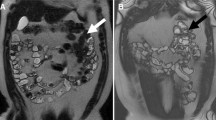Abstract
Object
To assess the feasibility of magnetization transfer (MT) imaging of the bowel wall in patients with Crohn’s disease (CD), and to evaluate its utility for the detection of intestinal fibrosis.
Materials and methods
In this prospective study, 31 patients (age 39.0 ± 13.2 years) with CD were examined in a 1.5T MR scanner. To establish a standard of reference, two independent readers classified the patients in different disease states using standard MR enterography, available clinical data and histological findings. In addition to the standard protocol, a 2D gradient-echo sequence (TR/TE 32 ms/2.17 ms; flip angle 25°) with/without 1,100 Hz off-resonance prepulse was applied. MT ratios (MTR) of the small bowel wall were computed off-line on a pixel-by-pixel basis.
Results
The MT sequences acquired images of sufficient quality and spatial resolution for the evaluation of the small bowel wall without detrimental motion artefacts. In normal bowel wall segments, an intermediate MTR of 25.4 ± 3.4 % was measured. The MTR was significantly increased in bowel wall segments with fibrotic scarring (35.3 ± 4.0 %, p < 0.0001). In segments with acute inflammation, the mean MTR was slightly smaller (22.9 ± 2.2 %).
Conclusion
MT imaging of the small bowel wall is feasible in humans with sufficient image quality and may help with the identification of fibrotic scarring in patients with CD.




Similar content being viewed by others
References
Rieber A, Aschoff A, Nüssle K et al (2000) MRI in the diagnosis of small bowel disease: use of positive and negative oral contrast media in combination with enteroclysis. Eur Radiol 10:1377–1382
Adler J, Swanson SD, Schmiedlin-Ren P, Higgins PD, Golembeski CP, Polydorides AD, McKenna BJ, Hussain HK, Verrot TM, Zimmermann EM (2011) Magnetization transfer helps detect intestinal fibrosis in an animal model of Crohn disease. Radiology 259(1):127–135
Henkelman RM, Stanisz GJ, Graham SJ (2001) Magnetization transfer in MRI: a review. NMR Biomed 14(2):57–64
Schunk K, Metzmann U, Kersjes W, Schadmand-Fischer S, Kreitner KF, Duchmann R, Protzer U, Wanitschke R, Thelen M (1997) Follow-up of Crohn’s disease: can hydro-MRI replace fractionated gastrointestinal passage examination? Rofo 166(5):389–396
Schunk K, Kern A, Oberholzer K, Kalden P, Mayer I, Orth T, Wanitschke R (2000) Hydro-MRI in Crohn’s disease: appraisal of disease activity. Invest Radiol 35(7):431–437
Silverberg MS, Satsangi J, Ahmad T et al (2005) Toward an integrated clinical, molecular and serological classification of inflammatory bowel disease: Report of a Working Party of the 2005 Montreal World Congress of Gastroenterology. Can J Gastroenterol 19(Suppl A):5–36
Punwani S, Rodriguez-Justo M, Bainbridge A, Greenhalgh R, De Vita E, Bloom S, Cohen R, Windsor A, Obichere A, Hansmann A, Novelli M, Halligan S, Taylor SA (2009) Mural inflammation in Crohn disease: location-matched histologic validation of MR imaging features. Radiology 252(3):712–720
Maglinte DD, Gourtsoyiannis N, Rex D, Howard TJ, Kelvin FM (2003) Classification of small bowel Crohn’s subtypes based on multimodality imaging. Radiol Clin North Am 41:285–303
Harvey RF, Bradshaw JM (1980) A simple index of Crohn’s-disease activity. Lancet 1(8167):514
Landis JR, Koch GG (1977) The measurement of observer agreement for categorical data. Biometrics 33(1):159–174
Hanley JA, McNeil BJ (1982) The meaning and use of the area under the receiver operating characteristic (ROC) curve. Radiology 143:29–36
Boss A, Martirosian P, Küper K, Fierlbeck G, Claussen CD, Schick F (2006) Whole-body magnetization transfer contrast imaging. J Magn Reson Imaging 24(5):1183–1187
Stanisz GJ, Odrobina EE, Pun J, Escaravage M, Graham SJ, Bronskill MJ, Henkelman RM (2005) T1, T2 relaxation and magnetization transfer in tissue at 3T. Magn Reson Med 54(3):507–512
Li JG, Graham SJ, Henkelman RM (1997) A flexible magnetization transfer line shape derived from tissue experimental data. Magn Reson Med 37(6):866–871
Schreyer AG, Rath HC, Kikinis R, Völk M, Schölmerich J, Feuerbach S, Rogler G, Seitz J, Herfarth H (2005) Comparison of magnetic resonance imaging colonography with conventional colonoscopy for the assessment of intestinal inflammation in patients with inflammatory bowel disease: a feasibility study. Gut 54(2):250–256
Taylor SA, Punwani S, Rodriguez-Justo M, Bainbridge A, Greenhalgh R, De Vita E, Forbes A, Cohen R, Windsor A, Obichere A, Hansmann A, Rajan J, Novelli M, Halligan S (2009) Mural Crohn disease: correlation of dynamic contrast-enhanced MR imaging findings with angiogenesis and inflammation at histologic examination–pilot study. Radiology 251(2):369–379
Rimola J, Rodriguez S, García-Bosch O, Ordás I, Ayala E, Aceituno M, Pellisé M, Ayuso C, Ricart E, Donoso L, Panés J (2009) Magnetic resonance for assessment of disease activity and severity in ileocolonic Crohn’s disease. Gut 58(8):1113–1120
Horsthuis K, Bipat S, Bennink RJ, Stoker J (2008) Inflammatory bowel disease diagnosed with US, MR, scintigraphy, and CT: meta-analysis of prospective studies. Radiology 247:64–79
Gourtsoyiannis N, Grammatikakis J, Papamastorakis G et al (2006) Imaging of small intestinal Crohn’s disease: comparison between MR enteroclysis and conventional enteroclysis. Eur Radiol 16:1915–1925
Stange EF, Travis SP, Vermeire S et al (2006) European Crohn’s and Colitis Organisation. European evidence-based consensus on the diagnosis and management of Crohn’s disease: definitions and diagnosis. Gut 55(suppl 1):i1–i15
Author information
Authors and Affiliations
Corresponding author
Rights and permissions
About this article
Cite this article
Pazahr, S., Blume, I., Frei, P. et al. Magnetization transfer for the assessment of bowel fibrosis in patients with Crohn’s disease: initial experience. Magn Reson Mater Phy 26, 291–301 (2013). https://doi.org/10.1007/s10334-012-0355-2
Received:
Revised:
Accepted:
Published:
Issue Date:
DOI: https://doi.org/10.1007/s10334-012-0355-2




